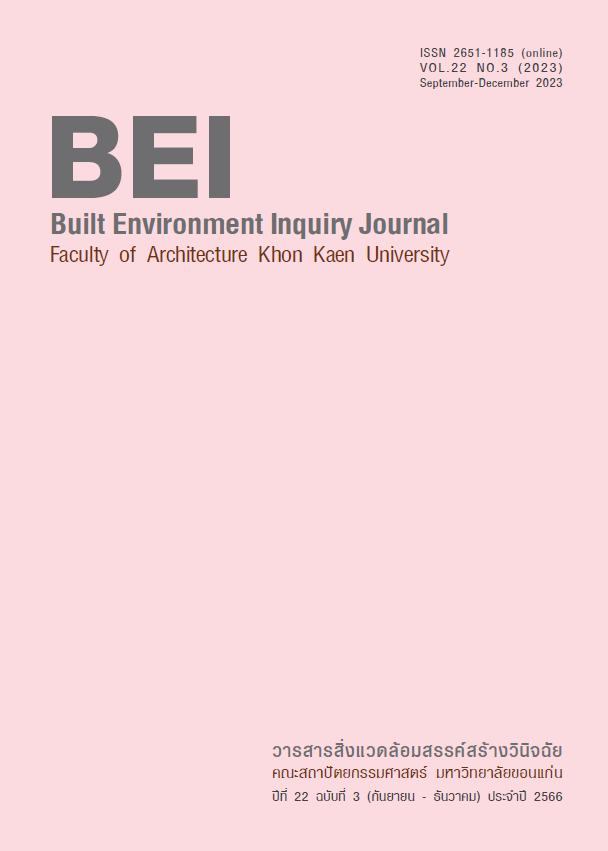Inno ati e Artificial Wooden Poles Made from Discarded Plastic to Create Beach Wave Fence Lines
DOI:
https://doi.org/10.14456/bei.2023.19Keywords:
Artificial Wooden Poles, Wa e Resistant, Sediment Trap, Waste PlasticAbstract
Thailand’s coastal erosion from wa es and winds has caused the coastline to be eroded
to the point that no beach area remains. arious constructions were used to sol e problems but
found that while they did so, they also produced new issues. Using bamboo wa e fencing is one
solution to coastal erosion. Howe er, the natural currently used materials, including solid wood,
bamboo. Eucalyptus wood, and pine wood, ha e limitations, namely a short ser ice life, non-durable
condition, easy to decay. This has resulted in wasting budget and fails to sustainably address beach
erosion. Therefore, the researcher has designed and de eloped an inno ati e artificial wooden poles
to replace the original natural wooden ones from plastic waste to sol e the problem of plastic
waste and reduce the use of natural resources. This also reduces en ironmental impact and protects
the integrity of coastal ecosystems.
The artificial wooden poles were designed to mimic the shape of mangro e plant root
systems along the seashore, such as A icennia trees, then the materials were made as artificial
wooden poles in pencil-like shapes (Pneumatophore). Waste plastics are processed through the
process of refinement, melting and molding according to the specified drawings, then reused as a
substitute for real wood and tested for engineering strength. The impact of ocean wa es were calculated
at a standard le el to compare the force generated by the wa es. The results showed that
the force generated by the wa es was 108.421 times lower than the force used in laboratory tests.
It can be concluded that the plastic rod workpiece is exceptionally strong. They can be used as wa
e-proof artificial wooden poles as they can bear the action force caused by wa es in the sea effecti
ely. In addition, they can also reduce the force or break down the energy from the impact of
the wa es. In addition, to increase the efficiency of the use of artificial wooden poles to pre ent wa
es, the beach artificial pole fence has been designed in a serrated shape to increase the breaking
of the wa es and turbulence both in front of and behind the fence line. It is a wa e energy breakdown
line that hits the beach and traps sand silt behind the wa e fence that helps create sandy beaches
and coastal dunes in order to reduce beach erosion sustainably.
References
กรมทรัพยากรทางทะเลและชายฝั่ง. (2559). คู่มือองค์ความรู้ แนวคิดระบบกลุ่มหาด (Littoral Cell)
ในประเทศไทยกับการแก้ไขปัญหาการกัดเซาะชายฝั่ง : กรมทรัพยากรทางทะเลและชายฝั่ง กระทรวง ทรัพยากรธรรมชาติและสิ่งแวดล้อม
กรมทรัพยากรทางทะเลและชายฝั่ง. (2561). แนวทางการจัดทำแผนงาน/โครงการป้องกันและแก้ไขปัญหาการกัด เซาะชายฝั่ง. กองบริหารจัดการพื้นที่ชายฝั่ง กระทรวงทรัพยากรธรรมชาติและสิ่งแวดล้อม
บริษัท เอส ที เอส เอ็นจิเนียริ่ง คอนซัลแตนท์. (2560.) รายงานผลกระทบสิ่งแวดล้อมเบื้องต้น โครงการก่อสร้าง เขื่อนป้องกันการกัดเซาะชายฝั่งทะเล พื้นที่ชายฝั่งหาดทรายแก้ว ตำบลชิงโค อำเภอสิงหนคร จังหวัด สงขลา (ภายใต้โครงการออกแบบและศึกษาผลกระทบสิ่งแวดล้อม เขื่อนป้องกันการกัดเซาะชายฝั่งทะเล (ระยะที่ 4) จังหวัดสงขลา
ศักดิ์อนันต์ ปลาทอง. (2564). หลักการปักรั้วไม้สลายคลื่น. คณะวิทยาศาสตร์ : มหาวิทยาลัยสงขลานครินทร์. จังหวัดสงชลา
สำนักงานเลขาธิการสภาผู้แทนราษฎร. (2564). รายงานผลการพิจารณาศึกษาของคณะกรรมาธิการวิสามัญพิจารณา ศึกษาแนวทางการแก้ไขปัญหาคลื่นทะเลกัดเซาะชายฝั่งและการพัฒนาทรัพยากรธรรมชาติทางทะเลอย่าง เป็นระบบ. กรุงเทพมหานคร
สถาบันพัฒนาบุคลากรด้านการพัฒนาเมือง (2561) องค์ความรู้ตามประเด็นยุทธศาสตร์ ด้านการพัฒนาเมือง ดำเนินการจัดทำตามแผนการจัดการความรู้กรมโยธาธิการและผังเมือง ( DPT KM Action Plan ) ประจำปี งบประมาณ พ.ศ.2561 : กรุงเทพมหานคร. สำนักพิมพ์ :บริษัท เพรส ครีเอชั่น จำกัด
สายใจ สโมสร. (2556) ระบบรากพืชและอัตราการตกตะกอนในป่าชายเลนหลังแนวไม้ไผ่ชะลอคลื่น จังหวัด สมุทรสาคร. วิทยานิพนธ์ คณะวิทยาศาสตร์ จุฬาลงกรณ์มหาวิทยาลัย. กรุงเทพมหานคร
Beach For Life. (2022). งบประมาณสร้างกำแพงกันคลื่น 2554-2565 โดยกรมโยธาธิการและผังเมือง. สืบค้นเมื่อ 15 มิถุนายน 2565. จาก https://www.tinyurl.com/
Sano, M., Jim_enez, J.A., Medina, R., Stanica, A., S-Arcilla, A., Trumbic, I., 2011. The role of coastal setbacks in the context of coastal erosion and climate change. Ocean Coast.
Manag. 54, (pp 943–950).
Downloads
Published
How to Cite
Issue
Section
License
Copyright (c) 2023 Built Environment Inquiry

This work is licensed under a Creative Commons Attribution-NonCommercial-NoDerivatives 4.0 International License.
Views and opinions expressed in the journal do not necessarily reflect those of the editors.



